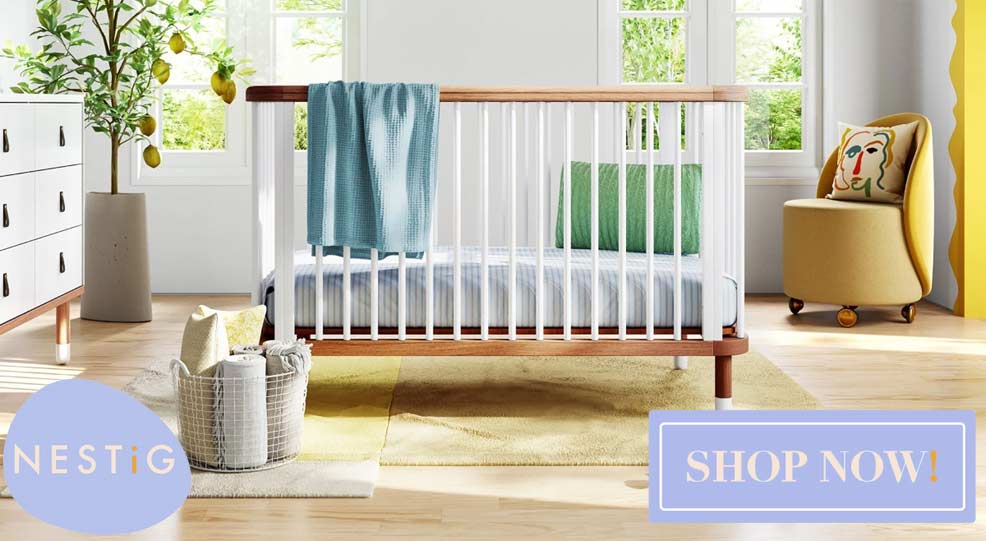History of the Stroller in 25 Fascinating Photos
From pram to present day, a fun and nostalgic look at the history of strollers.
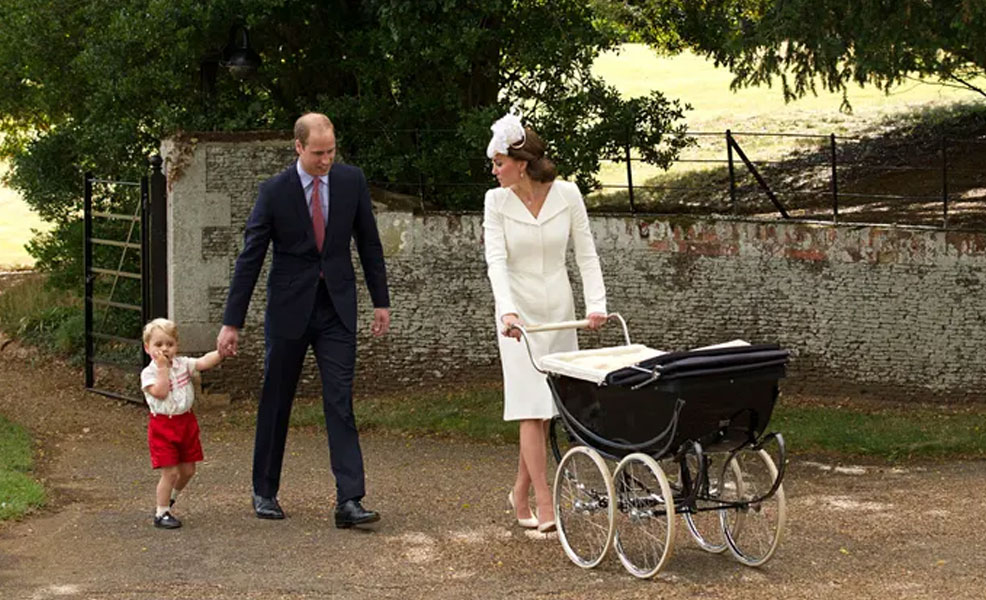
Mommyhood101 independently tests and curates baby gear to help you make informed decisions. If you buy products through links on our site, we may earn a commission.
The stroller was first invented way back in 1733 by William Kent, who was an architect and the designer of the Royal Garden.
He developed it for the Duke of Devonshire's children, and it was commonly referred to as a pram, baby carriage, or perambulator. Strollers have come a long way since then, as you can see in our annual round-up of the best strollers.
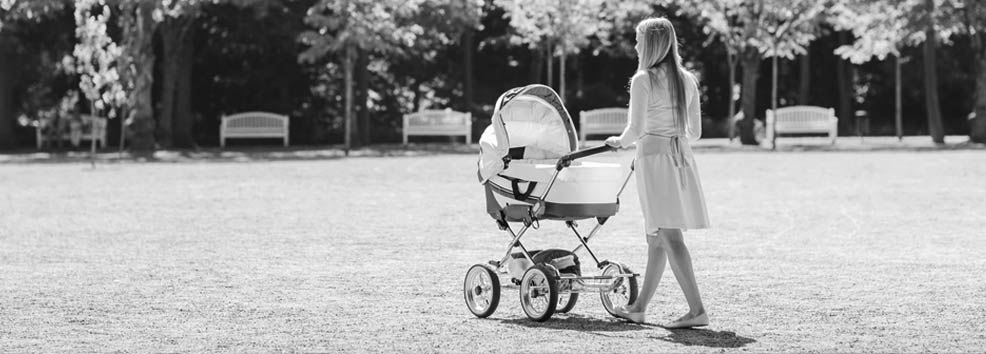
The First Stroller in History
Kent's pram was very ornate, shaped like a shell with a curved slipper toe up front, and made of wicker. It had long snake-shaped harnesses that were attached to an animal (like a horse-drawn carriage or dogsled). The snake designs are in several places on the pram; not surprisingly, the snake was part of the Devonshire shield, and for this reason, added to the pram's royal distinctiveness. Called the Chatsworth Serpent Pram, it received a lot of attention but only a few were made given the high cost and laborious design.
In the photos below, notice the crushed velvet seat, the red silk canopy, the intricate suspension system, the two snake heads sticking out up front, and the serpent-like harness. Another thing to notice is that there was no handlebar for parents or other caregivers (usually a nurse) - that's because this pram was meant to be pulled by a goat or other animal!
Being pulled around by a goat wasn't particularly odd at the time, and even the children of President Harrison were pulled in a cart by a goat around the white house lawn!
While it certainly looks fancy, it also looks very uncomfortable for babies. Unfortunately, we couldn't dig up photos of babies in this beauty, but it's hard to imagine that this could be comfortable or easy to slide your baby in and out of!
The First Stroller: 1733 by William Kent
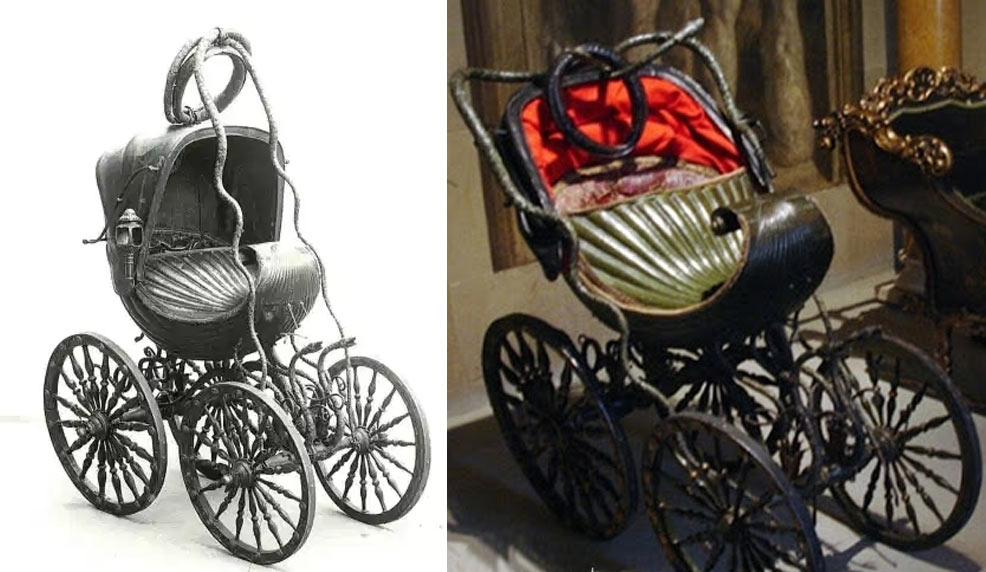
After Kent's original contribution to the British royal family, several variants of his stroller were developed, some of which made it to a wider market.
Through the 1700s and early 1800s, having a baby carriage was a status symbol for wealth, being out of reach to most people due to the high cost. They were extremely rare, and most parents simply kept their babies at home.
The First Hand-Pushed Stroller
In America in 1848, Mr. Charles Burton designed the first baby carriage that allowed parents and caregivers to push their baby around, rather than needing a small animal to do the pulling.
Burton designed a three-wheel baby carriage (and a four-wheel variant) that was overall pretty basic. We will say that the seat did look comfy enough, and it's nice that it had a boot cover built in.
The artist's rendering of this new concept, used in advertisements at the time, was truly hilarious, depicting a nurse or parent pushing a toddler while wearing what appeared to be a giant canopy on their head to shield the child from the elements (see the center image below).
Apparently, it never dawned on Mr. Burton that perhaps a canopy could be attached to the stroller itself.
This new baby carriage apparently didn't sell very well in the U.S. but became a hit in England.
The First Push-Stroller by Charles Burton

The First Stroller Patent
It wasn't until 1889 that the first baby carriage patent was filed for the design of a stroller, by William Richardson. The original patent and a few versions of his design can be seen below, and you can read about his patent in depth at Google Patents. That's not to say other baby carriages weren't made between Kent's pram and the filing of this patent; certainly, there were others, most of which involved a wicker basket placed atop a basic metal frame structure with wheels.
But Mr. Richardson's design expanded upon that with a lot of impressive features for the time: spring-based suspension, a large umbrella-style canopy, a bassinet-style basket that rotated 180 degrees to face either direction, wheels that rotated independently (to help with turning), and the ability for the baby to lay flat or sit in a chair towards the back.
A funny quote from the patent application suggests some concern about a free-spinning basket being too tempting to spin around repeatedly, motivating the designer to use a stop that only allowed it to rotate 180 degrees (so it could not be turned completely around).
...it is possible that in the hands of a careless and incompetent nurse the rotation of the body could be indulged in to such an extent as to prove detrimental to the child.
First Patented Stroller: 1889 by William Richardson
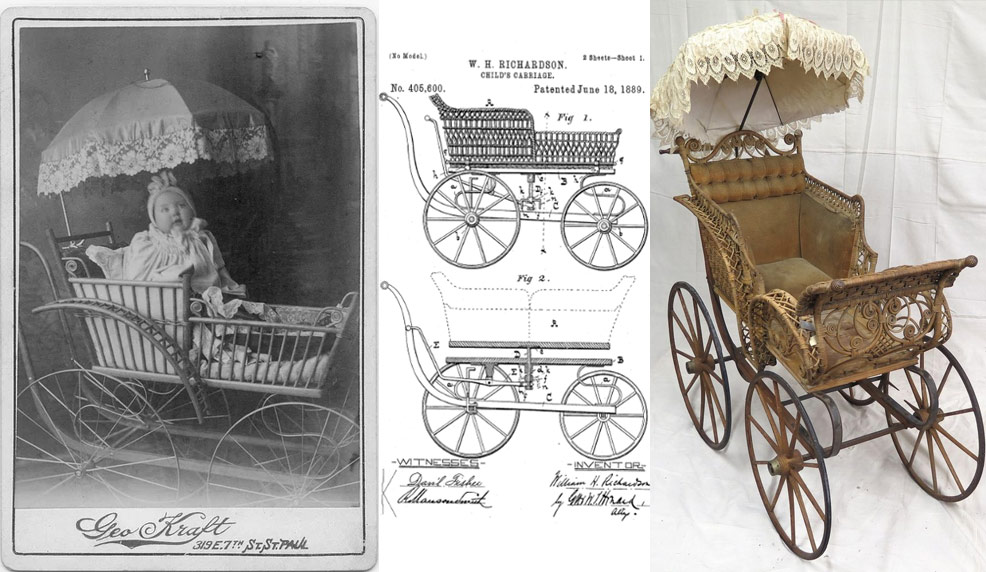
This stroller was a nice advancement over what existed previously, which were basically wheelchairs for babies, taking a small wooden chair and adding a few wheels to it.
One critical difference versus the Kent carriage was that parents and caregivers could push or pull the carriages themselves, no longer needing an animal to lug their child around.
The initial patent laid a foundation for several developments in stroller history, including a boom of manufacturing and popularity in England and other parts of Europe, slowly extending to the U.S.
Strollers were slowly becoming very common among the wealthier citizens of major European cities such as London and Paris, and many of the wicker basket-style designs were originating in France. Originally, many strollers were pulled instead of pushed, perhaps owing to their weight and difficulty in pushing around.
These early strollers were commonly called perambulators, with "per" meaning through and "ambulate" meaning walk. Given that much of this was happening in the middle of the Victorian Era, the distinctive styling is not entirely surprising.
Some Cool 1890's Strollers
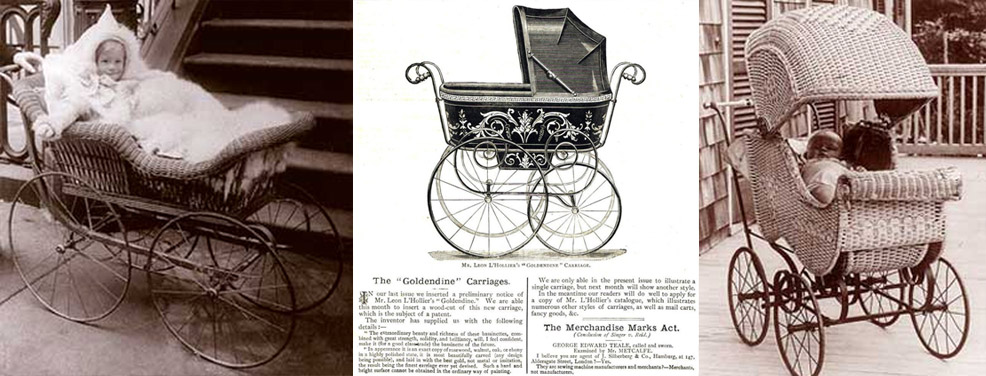
Many of these strollers were made by companies such as Wakefield Rattan, the Heywood Brothers, Gendron Wheel, and F. A. Whitney Carriage Co.
Wakefield Rattan and Heywood Brothers would eventually merge companies by the end of the 19th century and developed strollers under the name Heywood Wakefield through the early 1900s.
Another variety during the 1890s was the Leon L'Hollier's Goldendine Carriage, which is depicted in the center of the above image. The Goldendine carriage used real gold decoration and was one of the sturdiest baby carriages of the time. As noted in their press release:
After repeated and violent blows with a hammer, it has shown no tendency to break or split...
I'm convinced!
Some More Vintage Strollers from the Era
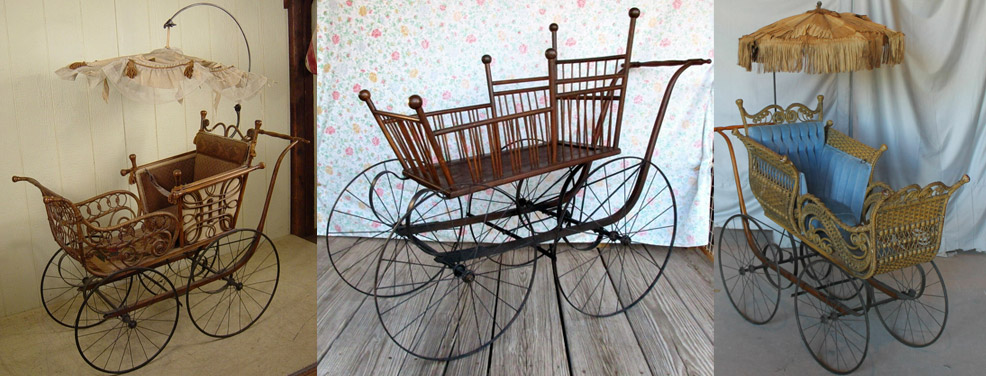
Looking at these strollers now, you realize that they are both similar and dramatically different from modern strollers. They have similar overall features - wheels, handlebars, sun shade, padded seats, seat belts (at least one of them that we can see!), and some versatility for sitting or lying down.
But what's most striking is the difference in safety standards. Can you imagine the number of pinching, choking, laceration, and entrapment hazards that these must have had!? From sticking your fingers through the wicker, slicing your hand on an iron wheel, or sliding and bouncing completely out of a stroller without a harness, safety was definitely an afterthought! One common issue with these strollers was tipping over both sideways and front-to-back.
Strollers in the Early 1900s
It's important to realize that plastics didn't become completely mainstream until the mid-1900s, nor did aluminum or other lightweight composite materials. Instead, strollers were constrained to using materials that were available at the time, with lightweight wood used for wheel spokes, steel being used for frames, wood being used for the basket floor, and wicker around the sides. This made early strollers very heavy, coming in at upwards of 50 pounds for the earliest baby carriages!
Nowadays, even the biggest double strollers tend to weigh about half that much, usually around 25-30 pounds.
Some of the more popular pram companies in the early 1900s were Haywood Wakefield, F. A. Whitney, W.J. Harris & Co., Lloyd Loom Products, and John Wilde & Sons.
Advances during this period included rubberized tires and handles, tightly-knit woven wicker, collapsible footrests, parking brakes, lower frames (with a safer and lower center of gravity), and retractable canopies. You also notice an introduction of more fabrics, rubber, leather, a few plastic parts, and even a bit of chrome here and there.
Baby Carriages - Early 1900's

Strollers were still pretty expensive at this point, a nice one being about $25-40, which is equivalent to about $700 nowadays. But now upper-middle and upper-class families could afford the status symbol, and strollers were becoming increasingly common in U.S. cities and towns by the 1930's.
Another little phenomenon that was happening simultaneously was that children were getting interested in having their own baby carriages for their dolls, and several cute doll carriages were being made that largely matched the functionality and style of their full-size peers.
Strollers in the Mid-1900s
The Great Depression and Second World War led to a downturn in manufacturing and consumer spending and a bit of a slowdown in baby carriage innovation. People had more important things to worry about than strolling about town with their stylish new prams.
But once the 1950s hit, stroller manufacturing took an upturn and most families were able to afford at least one baby carriage for their children. Costs decreased, the use of plastics increased, and more safety measures were being implemented than ever before.
Baby Carriages - Mid-1900s

Notice the sudden style differences, largely due to replacing wood and wicker with plastic and other composite materials. Retractable canopies were standard, the lay-flat design was most popular, many had boot covers and extenders, rubber (some inflatable) tires were standard, and chrome became a primary visual feature.
Shiny, sleek lines, curved handlebars, fenders, parking brakes, and a few more safety features than before. Those included a much lower center of gravity, higher stability to prevent tips, and minimal places where fingers or other appendages could get into trouble.
Many of these pram-style baby carriages are popular today, as evidenced by how many luxury strollers and stroller travel sytems have a bassinet option.
You don't need to look further than the grocery store tabloids to see elite families, including Prince William and Duchess Kate, with their beautiful Silver Cross baby carriage - another example of a classic pram-style stroller.
But by the 1960s, a paradigm shift began to occur. Strollers were way too big and cumbersome to be practical, but parents wanted to be able to bring their strollers on travel, maybe even on an airplane, or simply toss them into the trunk of their car. This began a revolution in lightweight and compact strollers that culminated in the invention of the first folding umbrella stroller!
Baby Carriages - Lightweight & Foldable

Parents will likely recognize the name of who invented the first umbrella stroller, Owen MacLaren, because the Maclaren name is still pretty popular in strollers.
This one was called the Maclaren buggy and truly changed everything for strollers of the time. Once Maclaren started the trend, a bunch of other companies got involved and the market quickly became saturated with umbrella strollers by the late 1900's.
Strollers in the Late 1900s
The last thirty years of the 20th century saw a ton of substantial advancements in strollers, including advances in comfort, safety, versatility, and style.
In 1984, Phil Baechler invented the first jogging and running stroller, and named it the "Baby Jogger." His company, Racing Strollers Inc., only sold a few hundred for the first couple of years, but then popularity took off through the late 80's and early 90's. He made single and double stroller versions, and they sold for about $250-300.
1980's - The First Running Strollers
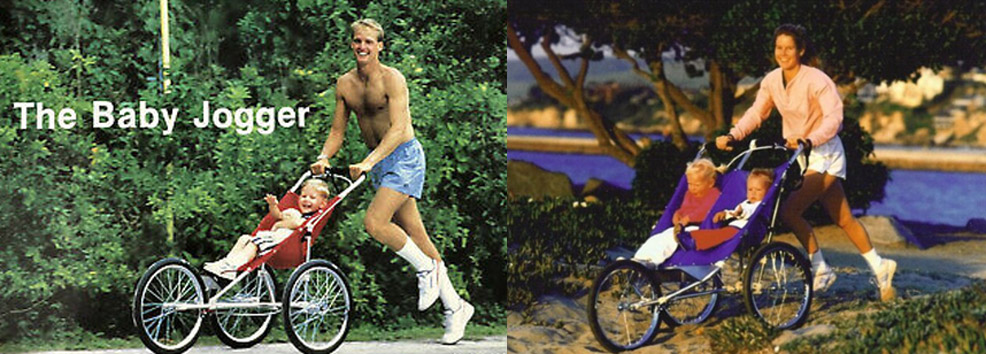
Modern Strollers
Strollers have certainly come a long way since the first baby carriage of the 1700s and all the iterations of carriages through the 19th and 20th centuries!
New safety features, more convenience, wider versatility (age, height, weight ranges), and more portability and comfort are all standard. There are also several varieties of the best strollers, including not only the lightweight and jogging strollers invented in the 80s, but also strollers that your car seat can attach to, can hold a bassinet, and can support up to three children.
For more details about modern strollers, be sure to check out our full stroller buying guide to learn how to pick the perfect stroller for your needs.
References
Boston Public Library, Digital Commonwealth historical photos. https://www.digitalcommonwealth.org/search
Buxton Museum & Gallery, historical photos. https://buxtonmuseumandartgallery.wordpress.com/
Google Patents, Patent No. 405,600. https://patents.google.com/patent/US405600A/en

